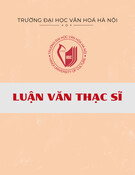
THE UNIVERSITY OF DANANG
UNIVERSITY OF FOREIGN LANGUAGE STUDIES
NGUYỄN THỊ MINH HẠNH
LINGUISTIC FEATURES OF VERBAL REPAIRS
IN ENGLISH AND VIETNAMESE
CONVERSATIONS
DOCTORAL DISSERTATION
IN SOCIAL SCIENCES AND HUMANITIES
Da Nang, 2021

THE UNIVERSITY OF DANANG
UNIVERSITY OF FOREIGN LANGUAGE STUDIES
NGUYỄN THỊ MINH HẠNH
LINGUISTIC FEATURES OF VERBAL REPAIRS
IN ENGLISH AND VIETNAMESE
CONVERSATIONS
Major: ENGLISH LINGUISTICS
Code: 9.22.02.01
DOCTORAL DISSERTATION
IN SOCIAL SCIENCES AND HUMANITIES
SUPERVISOR: Assoc.Prof.Dr. NGUYỄN THỊ QUỲNH HOA
Da Nang, 2021

i
TABLE OF CONTENTS
Page
Table of Contents ............................................................................................ i
List of Abbreviations ...................................................................................... v
CHAPTER 1: INTRODUCTION
1.1. Rationale ...................................................................................................... 2
1.2. Aims and Objectives ..................................................................................... 5
1.2.1. Aims of the Study .................................................................................... 5
1.2.2. Objectives of the Study ........................................................................... 5
1.3. Research Questions ....................................................................................... 5
1.4. Scope of the Study ........................................................................................ 6
1.5. Significance of the Study .............................................................................. 7
1.5.1. Theoretical Significance of the Study .................................................... 7
1.5.2. Practical Significance of the Study ........................................................ 8
1.6. Structure of the Thesis .................................................................................. 8
CHAPTER 2: LITERATURE REVIEW
2.1. Definitions of Terms ................................................................................... 10
2.2. Theoretical Background .............................................................................. 11
2.2.1. Conversation. ........................................................................................ 11
2.2.2. Conversation Analysis ........................................................................... 14
2.2.3. Utterances ............................................................................................. 20
2.2.4. Speech Act of Repair ............................................................................ 21
2.2.5. Linguistic Features of Verbal Repairs ................................................... 24
2.3. Previous Studies Related to the Study ......................................................... 37
2.4. Summary .................................................................................................... 44
CHAPTER 3: RESEARCH METHODOLOGY
3.1. Research Design ..................................................................................... 45
3.2. Research Methods ................................................................................... 47

ii
3.2.1. Data Collection Method ................................................................... 47
3.2.2. Data Analysis Method ....................................................................... 54
3.3. Data Coding Method ............................................................................... 54
3.4. Analytical Framework ............................................................................ 56
3.5. Reliability and Validity ........................................................................... 57
3.5.1. Reliability ......................................................................................... 57
3.5.2. Validity ............................................................................................ 58
3.6. Summary ................................................................................................ 58
CHAPTER 4: PRAGMATIC FEATURES OF VERBAL REPAIRS IN
ENGLISH AND VIETNAMESE TELEVISION FILM CONVERSATIONS
4.1. Pragmatic Features of Verbal Self-Repairs............................................... 60
4.1.1. Pragmatic Features of Verbal Self-Repair in EFCs ............................. 60
4.1.2. Pragmatic Features of Verbal Self-Repair in VFCs ............................ 66
4.1.3. Similarities and Differences ............................................................... 72
4.2. Pragmatic Features of Verbal Other-Repairs ........................................... 73
4.2.1. Pragmatic Features of Verbal Other-Repair in EFCs ......................... 73
4.2.2. Pragmatic Features of Verbal Other-Repair in VFCs ......................... 82
4.2.3. Similarities and Differences ............................................................. 90
4.3. Summary ................................................................................................ 91
CHAPTER 5: SEMANTIC FEATURES OF VERBAL REPAIRS IN
ENGLISH AND VIETNAMESE TELEVISION FILM CONVERSATIONS
5.1. Semantic Features of Verbal Self-Repair in EFCs in Films ...................... 93
5.1.1. Relational Process ............................................................................. 95
5.1.2. Material Process ................................................................................ 98
5.1.3. Mental Process ................................................................................ 101
5.1.4. Verbal Process ................................................................................ 102
5.1.5. Existent Process .............................................................................. 104
5.2. Semantic Features of Verbal Self-Repair in VFCs in Films ................... 105
5.2.1. Relational Process ........................................................................... 107
5.2.2. Material Process .............................................................................. 109

iii
5.2.3. Mental Process ................................................................................ 111
5.2.4. Verbal Process ................................................................................ 113
5.2.5. Existental Process ........................................................................... 114
5.2.6. Similarities and Differences ........................................................... 115
5.3. Semantic Features of Verbal Other-Repair in EFCs ............................... 116
5.3.1. Relational Process ........................................................................... 119
5.3.2. Material Process .............................................................................. 123
5.3.3. Verbal Process ................................................................................ 127
5.3.4. Mental Process ................................................................................ 129
5.3.5. Existential Process .......................................................................... 133
5.4. Semantic Features of Verbal Other-Repair in VFCs .............................. 134
5.4.1. Relational Process ........................................................................... 136
5.4.2. Verbal Process ................................................................................ 139
5.4.3. Material Process .............................................................................. 140
5.4.4. Mental Process ................................................................................ 145
5.4.5. Existential Process ......................................................................... 149
5.4.6. Similarities and Differences ............................................................ 151
5.5. Summary .............................................................................................. 152
CHAPTER 6: SYNTACTIC FEATURES OF VERBAL REPAIRS IN
ENGLISH AND VIETNAMESE TELEVISION FILM CONVERSATIONS
6.1. Syntactic Features of Verbal Self-Repair in EFCs .................................. 154
6.1.1. Self-Repair initiated after a Nominal Group .................................... 156
6.1.2. Self-Repair initiated after a Clause .................................................. 161
6.1.3. Self-Repair initiated after a Verbal Group ....................................... 164
6.1.4. Self-Repair initiated after a Prepositional Phrase ............................. 165
6.2. Syntactic Features of Verbal Self-Repair in VFCs ................................. 166
6.2.1. Self-Repair initiated after a Nominal Group .................................... 168
6.2.2. Self-Repair initiated after a Verbal Group ....................................... 174
6.2.3. Self-Repair initiated after a Prepositional Phrase ............................. 175
6.2.4. Self-Repair initiated after a Clause .................................................. 176









![Phát hiện và nhận dạng tiếng Việt trong ảnh CCCD, ảnh ngoại cảnh: Nghiên cứu phương pháp nâng cao độ chính xác [Luận án Tiến sĩ]](https://cdn.tailieu.vn/images/document/thumbnail/2025/20250807/vijiraiya/135x160/7691754555235.jpg)
















